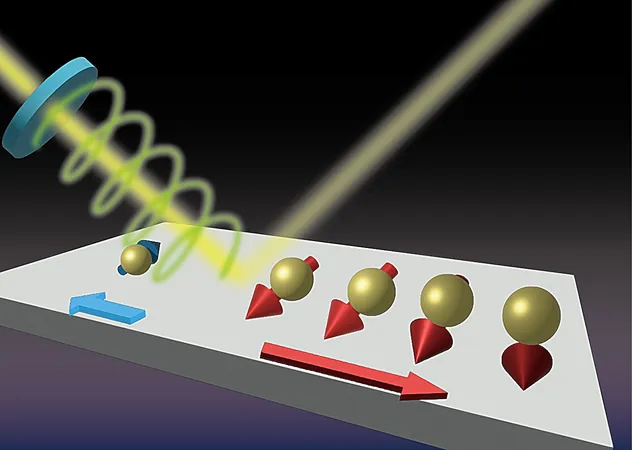
Breakthrough Discovery: Single-Atom Metal Layer Controls Spin-Polarized Current with Light!
2025-01-10
Author: Siti
Breakthrough Discovery: Single-Atom Metal Layer Controls Spin-Polarized Current with Light!
Researchers at the University of Tokyo have made a groundbreaking discovery that challenges established norms in the field of electronics. In an astonishing study, they found that a single-layer thallium-lead alloy can confine the direction of spin-polarized current to one specific pathway when exposed to light—remarkably, this occurs at room temperature.
Traditionally, single-atom layers were considered nearly transparent and ineffective for light absorption or interaction. However, this innovative research uncovers a one-directional current flow that suggests unprecedented capabilities for functionalities that surpass those of conventional diodes. This advancement heralds promising prospects for eco-friendly data storage solutions and ultra-compact two-dimensional spintronic devices in modern electronics.
The Role of Diodes in Electronics
Diodes serve as the cornerstone of electronic systems, directing current flow effectively. Yet, as device scales shrink, developing these crucial components becomes increasingly complex. The researchers focused on the principles of spintronics—technology harnessing the intrinsic spin of electrons—as their foundation, aiming to manipulate this spin through light.
"Traditionally, spintronics has dealt with materials that are significantly thicker," explained Ryota Akiyama, a leading researcher in the study. "Our interest in ultra-thin systems stemmed from their remarkable properties, and we set out to examine the conversion of light into spin-polarized current within these two-dimensional frameworks."
Circular Photogalvanic Effect (CPGE) and Research Findings
This light-to-spin-polarized-current conversion is characterized by the circular photogalvanic effect (CPGE), where the alignment of electron spins determines the unidirectional flow of electrical current based on light polarization, akin to how conventional diodes rely on voltage polarity for current direction.
Utilizing thallium-lead alloys, the research team aimed to observe these phenomena even at the atomic scale. They conducted their experiments under ultra-high vacuum conditions—eliminating contaminants like oxygen—to reveal the true characteristics of the alloys. Upon irradiating the material with circularly polarized light, startling shifts in both current direction and intensity were witnessed.
Akiyama noted, "Perhaps the most surprising element was discovering a spin-polarized current, where the direction of electron spins aligned with that of the current, thanks to the unique properties of these thin alloys."
Future Implications and Applications
This development is not merely academic. The research team had previously discovered unique electronic properties in thin alloys, paving the way for their current study. Looking ahead, Akiyama envisions exciting applications stemming from this research.
"Our findings underscore the significance of fundamental research for future applications. Our immediate goal is to enhance our system further. Next, we aim to explore novel two-dimensional alloys with distinct electronic characteristics, and we plan to experiment with lower-energy terahertz lasers to streamline CPGE excitation paths, significantly boosting the efficiency of light conversion into spin-polarized current."
This pioneering work not only advances our understanding of spintronics but could revolutionize the future of technology, making devices smaller, more efficient, and environmentally sustainable. Keep an eye on what's next from this innovative team as they forge ahead in the world of thin-layer systems!

 Brasil (PT)
Brasil (PT)
 Canada (EN)
Canada (EN)
 Chile (ES)
Chile (ES)
 Česko (CS)
Česko (CS)
 대한민국 (KO)
대한민국 (KO)
 España (ES)
España (ES)
 France (FR)
France (FR)
 Hong Kong (EN)
Hong Kong (EN)
 Italia (IT)
Italia (IT)
 日本 (JA)
日本 (JA)
 Magyarország (HU)
Magyarország (HU)
 Norge (NO)
Norge (NO)
 Polska (PL)
Polska (PL)
 Schweiz (DE)
Schweiz (DE)
 Singapore (EN)
Singapore (EN)
 Sverige (SV)
Sverige (SV)
 Suomi (FI)
Suomi (FI)
 Türkiye (TR)
Türkiye (TR)
 الإمارات العربية المتحدة (AR)
الإمارات العربية المتحدة (AR)